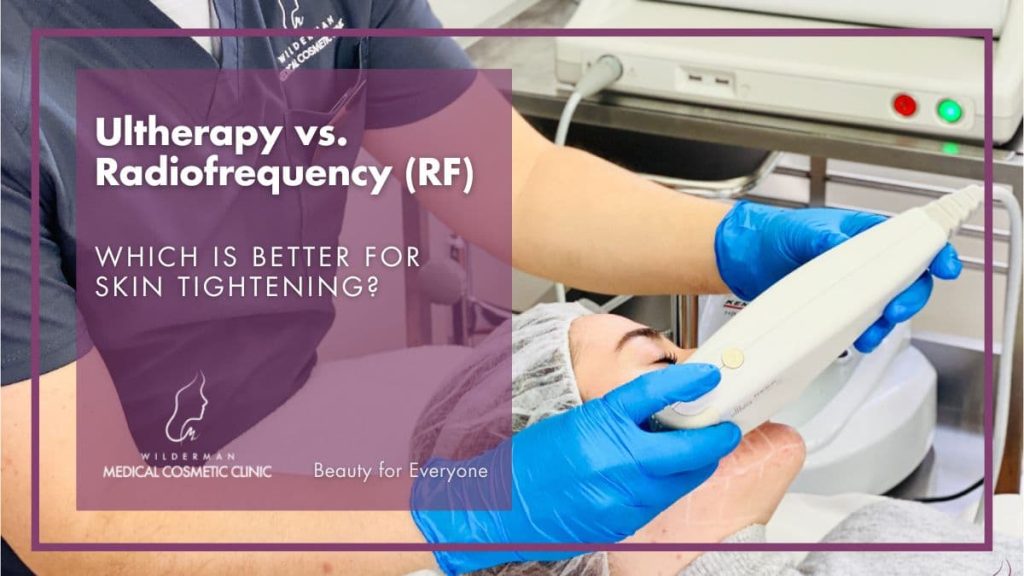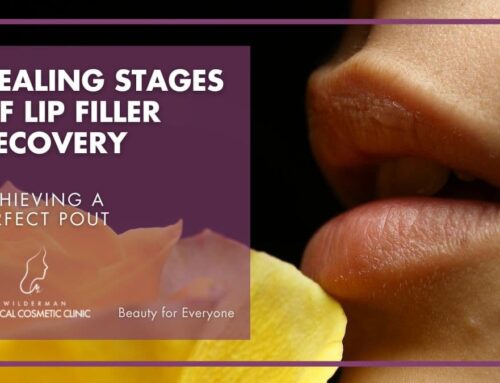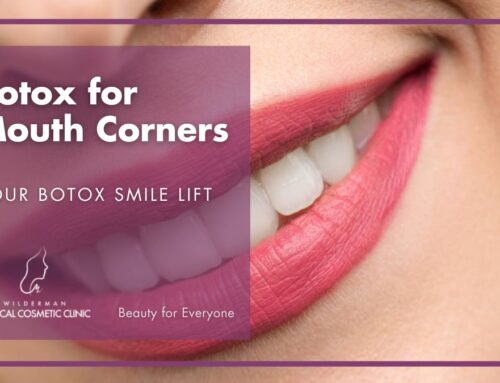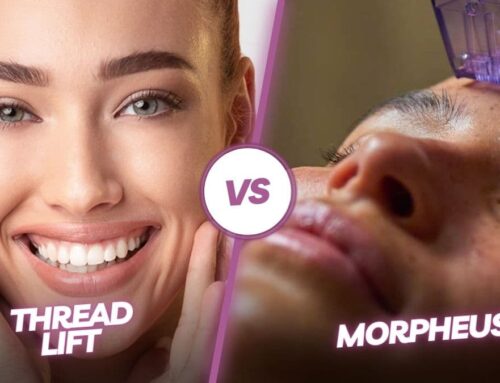Ultherapy vs. Radiofrequency (RF) Skin Tightening
Which is Better for Skin Tightening?
As the pursuit of youthful, radiant skin continues to be a top priority for many individuals, the cosmetic industry has responded with an array of advanced treatments. Surgery isn’t the only choice for firmer, wrinkle-free skin.
Are you currently contemplating whether Ultherapy or Radiofrequency (RF) is the better option for skin tightening?

Get immediate answers to your questions about treatment options, costs, expected outcomes, and more.
- Expert Diagnosis
- Customized Treatment Plans
- No Obligation
- Comfort and Privacy
- Immediate Answers
The truth is, that both options offer remarkable solutions for addressing saggy skin and reversing skin laxity.
Furthermore, you can expect satisfying outcomes from either treatment when it comes to contouring the cheeks, elevating the brow, and tightening sagging jowls.
Nevertheless, there exist notable distinctions between these two procedures, which could influence your decision. So, let’s delve deeper into the world of Radiofrequency versus Ultherapy.
What is the Difference Between Radiofrequency and Ultherapy?
Radiofrequency (RF) and Ultherapy are both non-invasive skin tightening treatments, but they use different technologies to achieve similar goals. Here’s a straightforward comparison of the two:
- Technology
- RF (Radiofrequency): RF treatments use radiofrequency energy to heat the deeper layers of the skin. This heat stimulates collagen and elastin production, leading to tighter and firmer skin.
- Ultherapy: Ultherapy, on the other hand, employs focused ultrasound energy. It targets specific layers of the skin and underlying tissues, also triggering collagen production to tighten and lift the skin.
- Depth of Treatment
- RF: RF energy typically penetrates the skin to a moderate depth, making it effective for treating mild to moderate skin laxity.
- Ultherapy: Ultherapy can reach deeper layers of skin and tissues, making it suitable for addressing more significant skin sagging and laxity.
- Results
- RF: RF treatments often provide more immediate results, with continued improvement over time as collagen rebuilds.
- Ultherapy: The results from Ultherapy may take a few months to fully manifest as collagen production gradually increases. However, the results are generally longer-lasting.
- Comfort
- RF: RF treatments are usually more comfortable during the procedure, with minimal discomfort reported by most patients.
- Ultherapy: Ultherapy can be uncomfortable for some patients, and they may require a topical numbing cream or pain medication to manage discomfort.
- Downtime
- RF: There is typically little to no downtime associated with RF treatments, allowing patients to return to their regular activities immediately.
- Ultherapy: While there is usually no downtime, some patients may experience minor redness or swelling that subsides within a few hours to a day.
- Number of Sessions
- RF: Multiple RF sessions may be needed to achieve optimal results, depending on the individual and the treatment area.
- Ultherapy: In many cases, a single Ultherapy treatment is sufficient to achieve the desired results.
Can You Use the Procedures Together?
Combining Ultherapy and RF treatments is a strategy some individuals and dermatologists explore to maximize skin tightening results. The rationale behind this approach is that the two methods target different layers of the skin. Ultherapy penetrates deeper, working on the foundational layers, while RF primarily focuses on the middle layers.
When used together, they can complement each other to provide more comprehensive results. However, it’s essential to consult with a qualified dermatologist or practitioner to determine the suitability of this approach for your specific needs.
Pros of Ultherapy
Non-Surgical: Ultherapy is a non-surgical procedure, which means no cutting or surgery is involved. This reduces the risks associated with surgery.
Minimal Downtime: You can usually go about your normal activities right after the treatment, as there is very little recovery time needed.
Natural-Looking Results: Ultherapy stimulates your skin to produce more collagen, which naturally tightens and lifts your skin. This means your results look gradual and not overly dramatic.
Long-Lasting: The effects of Ultherapy can last for a year or even more, making it a lasting solution for skin tightening.
Precise Targeting: Ultrasound imaging allows the treatment to be precisely focused on the areas that need it most, ensuring efficient and effective results.
Cons of Ultherapy
Discomfort: Some people may experience discomfort or pain during the procedure. This can vary from person to person, and your doctor may provide ways to manage it.
Gradual Results: While you may notice immediate improvements, it can take a few months for the full effects to become visible as collagen production continues.
Possible Side Effects: Though rare, you might experience temporary side effects like redness, swelling, bruising, or tingling.
Not for Everyone: Ultherapy may not be suitable for people with certain medical conditions or skin types. Your doctor will assess if it’s the right option for you.
Limited Areas: Ultherapy is mainly used for the face and neck, so it may not be the best choice for loose skin in other body areas.
Pros of Radiofrequency
Non-Surgical: RF skin tightening is a non-invasive procedure as well.
Minimal Discomfort: Most patients find RF treatments to be comfortable and well-tolerated, with little to no pain involved.
No Downtime: You can typically resume your regular activities immediately after an RF treatment, as there’s usually no need for recovery time.
Quick Results: RF treatments often yield noticeable improvements in skin tightness and texture, sometimes even after the first session.
Collagen Boost: RF stimulates the production of collagen, a crucial protein for skin firmness, which leads to long-lasting results.
Versatile: RF can be used on various body areas, including the face, neck, arms, and abdomen, making it suitable for different skin tightening needs.
Cons of Radiofrequency
Temporary Results: The effects of RF treatments are not permanent and may require occasional maintenance sessions to sustain the results.
Multiple Sessions: Some patients may need multiple RF sessions to achieve their desired level of skin tightening, depending on the individual and the treatment area.
Skin Type Consideration: While RF is generally safe for various skin types, it may not be suitable for individuals with specific medical conditions or certain skin conditions. Consult with your doctor for a personalized assessment.
Less Dramatic Than Surgery: RF treatments provide more subtle results compared to surgical procedures like facelifts, so they may not be suitable for individuals seeking very dramatic changes.
Maintenance Required: To maintain the benefits, occasional follow-up sessions may be necessary, which can add to the overall cost.
Takeaway: Which is Better for Skin Tightening?
The choice between Ultherapy and RF skin tightening depends on your specific skin concerns, preferences, and the guidance of a qualified healthcare provider. Both treatments offer effective non-surgical solutions for skin tightening, but they have differences to consider:
- Ultherapy is known for its precision, deeper tissue penetration, and longer-lasting results. It’s suitable for addressing significant skin laxity.
- Radiofrequency (RF) Skin Tightening is versatile, comfortable, and often provides more immediate but temporary improvements. It’s effective for mild to moderate skin laxity.
The “better” option varies from person to person. Some may prefer the lasting results of Ultherapy, while others may appreciate the comfort and versatility of RF. Consulting with a healthcare professional is crucial to determine which treatment aligns best with your unique needs and goals.
Reference
Cutis Medical Laser Clinics. (Nov 28, 2022). Non-Invasive Skin Tightening: Ultrasound, Radiofrequency, or Both? Retrieved from https://www.cutislaserclinics.com/blog/non-invasive-skin-tightening-ultrasound-radiofrequency-or-both/ (Accessed Sep 4, 2023).
Healthline. (Mar 16, 2021). Thermage vs. Ultherapy: Benefits, Cost, and More. Retrieved from https://www.healthline.com/health/thermage-vs-ultherapy#finding-a-provider (Accessed Sep 4, 2023).
AdvancedMD Aesthetics. (n.d.). Ultherapy vs RF Microneedling: Which Treatment Is Right for You? Retrieved from https://advancedmdaesthetics.com/ultherapy-vs-rf-microneedling/ (Accessed Sep 4, 2023).
Related content that may be of interest
What is Ultherapy? A non-invasive lift – Ultherapy is an FDA-approved, non-invasive procedure that lifts and tightens the skin. It is typically used to treat the skin of the neck, jawline, eyebrows, and décolletage. Ultherapy uses ultrasound waves to generate a thermal effect in the tissues below the surface …
Ultherapy for Jowls: Benefits, Results, Takeaways – Aging is a natural part of life, but that doesn’t mean you have to settle for sagging skin and jowls. As we grow older, our skin’s collagen and elastin production gradually declines, leading to the development of jowls – those pesky, droopy areas along the jawline and neck. Thankfully, modern advancements in cosmetic procedures offer …
Stay Ahead of the Beauty Curve
Beyond Beauty: Elevate Your Routine with Insider Tips and Breakthroughs – Subscribe Now!
Transform your beauty routine into something extraordinary!






